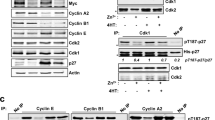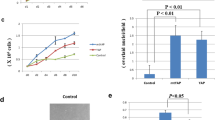Abstract
Jun dimerization protein 2 (JDP2) was identified as a bZIP protein that forms dimers with Jun proteins. JDP2 represses transcriptional activation of reporter constructs containing 12-O-tetradecanoylphorbol 13-acetate (TPA)-responsive elements (TRE) or cyclic AMP responsive elements (CRE). JDP2, overexpressed by the avian retroviral vector RCAS, induces partial oncogenic transformation of chicken embryo fibroblasts. JDP2-expressing cells form multilayered foci in monolayer cultures but do not show anchorage-independent growth. Both the carboxyl and the amino terminus of JDP2 are required for the transforming activity. Chimeric constructs of JDP2 carrying the leucine zipper domain of Fos, GCN4 or EB1 fail to transform CEF. The leucine zipper of Fos mediates only heterodimerization; it cannot homodimerize. In contrast, the leucine zippers of GCN4 and of EB1 exclusively homodimerize and do not form dimers with other bZip proteins. The results with the JDP2 chimeras suggest that the JDP2 homodimer and the JDP2/Jun heterodimer (or other bZip heterodimers formed with the Fos leucine zipper) are nontransforming, leaving as possible transforming combination the JDP2/Fos heterodimer. The unexpected transforming activity of a negative regulator of TRE- and CRE-dependent transcription raises an important question concerning the mechanisms of transformation by the related bZIP proteins Jun and Fos that address the same target sequences.
This is a preview of subscription content, access via your institution
Access options
Subscribe to this journal
Receive 50 print issues and online access
$259.00 per year
only $5.18 per issue
Buy this article
- Purchase on Springer Link
- Instant access to full article PDF
Prices may be subject to local taxes which are calculated during checkout







Similar content being viewed by others
References
Aoki M, Batista O, Bellacosa A, Tsichlis P and Vogt PK . (1998). Proc. Natl. Acad. Sci. USA, 95, 14950–14955.
Aronheim A, Zandi E, Hennemann H, Elledge SJ and Karin M . (1997). Mol. Cell. Biol., 17, 3094–3102.
Bos TJ, Monteclaro FS, Mitsunobu F, Ball AR, Jr Chang CH, Nishimura T and Vogt PK . (1990). Genes Dev., 4, 1677–1687.
Broder YC, Katz S and Aronheim A . (1998). Curr. Biol., 8, 1121–1124.
Brown PH, Alani R, Preis LH, Szabo E and Birrer MJ . (1993). Oncogene, 8, 877–886.
Brown PH, Kim SH, Wise SC, Sabichi AL and Birrer MJ . (1996). Cell Growth Differ., 7, 1013–1021.
Cohen SB, Waha A, Gelman IH and Vogt PK . (2001). Oncogene, 20, 141–146.
Curran T, Peters G, Van Beveren C, Teich NM and Verma IM . (1982). J. Virol., 44, 674–682.
Domann FE, Levy JP, Birrer MJ and Bowden GT . (1994). Cell Growth Differ., 5, 9–16.
Fu S, Bottoli I, Goller M and Vogt PK . (1999). Proc. Natl. Acad. Sci. USA, 96, 5716–5721.
Gao M, Morgan I and Vogt PK . (1996). Cancer Res., 56, 4229–4235.
Hai T and Curran T . (1991). Proc. Natl. Acad. Sci. USA, 88, 3720–3724.
Hsu JC, Laz T, Mohn KL and Taub R . (1991). Proc. Natl. Acad. Sci. USA, 88, 3511–3515.
Hwang HC, Martins CP, Bronkhorst Y, Randel E, Berns A, Fero M and Clurman BE . (2002). Proc. Natl. Acad. Sci. USA, 31, 31.
Jin C, Li H, Murata T, Sun K, Horikoshi M, Chiu R and Yokoyama KK . (2002). Mol. Cell. Biol., 22, 4815–4826.
Jin C, Ugai H, Song J, Murata T, Nili F, Sun K, Horikoshi M and Yokoyama KK . (2001). FEBS Lett., 489, 34–41.
Karin M, Liu Z and Zandi E . (1997). Curr. Opin. Cell Biol., 9, 240–246.
Kataoka K, Noda M and Nishizawa M . (1994). Mol. Cell. Biol., 14, 700–712.
Kataoka K, Noda M and Nishizawa M . (1996). Oncogene, 12, 53–62.
Kataoka K, Shioda S, Yoshitomo-Nakagawa K, Handa H and Nishizawa M . (2001). J. Biol. Chem., 276, 36849–36856.
Kruse U, Iacovoni JS, Goller ME and Vogt PK . (1997). Proc. Natl. Acad. Sci. USA, 94, 12396–12400.
Maki Y, Bos TJ, Davis C, Starbuck M and Vogt PK . (1987). Proc. Natl. Acad. Sci. USA, 84, 2848–2852.
Mathas S, Hinz M, Anagnostopoulos I, Krappmann D, Lietz A, Jundt F, Bommert K, Mechta-Grigoriou F, Stein H, Dorken B and Scheidereit C . (2002). EMBO J., 21, 4104–4113.
Morgan IM, Ransone LJ, Bos TJ, Verma IM and Vogt PK . (1992). Oncogene, 7, 1119–1125.
Nishizawa M, Kataoka K, Goto N, Fujiwara KT and Kawai S . (1989). Proc. Natl. Acad. Sci. USA, 86, 7711–7715.
Passegue E and Wagner EF . (2000). EMBO J., 19, 2969–2979.
Perez S, Vial E, van Dam H and Castellazzi M . (2001). Oncogene, 20, 1135–1141.
Piu F, Aronheim A, Katz S and Karin M . (2001). Mol. Cell. Biol., 21, 3012–3024.
Schreiber E, Matthias P, Muller MM and Schaffner W . (1989). Nucleic Acids Res., 17, 6419.
Schreiber M, Kolbus A, Piu F, Szabowski A, Mohle-Steinlein U, Tian J, Karin M, Angel P and Wagner EF . (1999). Genes Dev., 13, 607–619.
Shaulian E and Karin M . (2001). Oncogene, 20, 2390–2400.
Shaulian E and Karin M . (2002). Nat. Cell Biol., 4, E131–E136.
Shaulian E, Schreiber M, Piu F, Beeche M, Wagner EF and Karin M . (2000). Cell, 103, 897–907.
van Dam H and Castellazzi M . (2001). Oncogene, 20, 2453–2464.
Vasanwala FH, Kusam S, Toney LM and Dent AL . (2002). J. Immunol., 169, 1922–1929.
Vogt PK . (1969). Fundamental Techniques in Virology. Habel K, Salzmann NP (eds). Academic: New York, pp 198–211.
Vogt PK . (2001). Oncogene, 20, 2365–2377.
Vogt PK . (2002). Nat. Rev. Cancer, 2, 465–469.
Acknowledgements
This work was supported by grants from the National Cancer Institute. This is manuscript number 14291-MEM of the Department of Molecular and Experimental Medicine, The Scripps Research Institute. Lesli LeCompte and Mohamed Abu-Qaoud provided competent and dedicated technical assistance. We thank Dr George Miller for a gift of an EB1 clone, a gene of Epstein–Barr virus that codes for a Jun-related bZIP protein.
Author information
Authors and Affiliations
Corresponding author
Rights and permissions
About this article
Cite this article
Blazek, E., Wasmer, S., Kruse, U. et al. Partial oncogenic transformation of chicken embryo fibroblasts by Jun dimerization protein 2, a negative regulator of TRE- and CRE-dependent transcription. Oncogene 22, 2151–2159 (2003). https://doi.org/10.1038/sj.onc.1206312
Received:
Revised:
Accepted:
Published:
Issue Date:
DOI: https://doi.org/10.1038/sj.onc.1206312
Keywords
This article is cited by
-
The AP-1 repressor protein, JDP2, potentiates hepatocellular carcinoma in mice
Molecular Cancer (2010)
-
Suppression of cell-cycle progression by Jun dimerization protein-2 (JDP2) involves downregulation of cyclin-A2
Oncogene (2010)
-
JDP2 suppresses adipocyte differentiation by regulating histone acetylation
Cell Death & Differentiation (2007)



